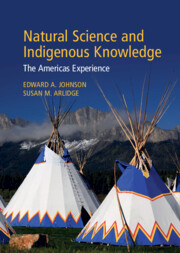Book contents
- Natural Science and Indigenous Knowledge
- Natural Science and Indigenous Knowledge
- Copyright page
- Contents
- Contributors
- Preface
- 1 What Do Indigenous People Have to Tell Us about the Cultural Landscapes They Have Created?
- 2 Reintegrating Cultural and Natural Landscapes
- 3 “My Uncle Was Resting His Country”: Dene Kinship and Insights into the More Distant Past
- 4 Native American Science in a Living Universe: A Paiute Perspective
- 5 “To Get More Harvest”
- 6 Hunting and Trapping in the Americas: The Assessment and Projection of Harvest on Wildlife Populations
- 7 On Fire and Water: The Intersection of Wetlands and Burning Strategies in Managing the Anthropogenic Plant Communities of Yosemite National Park
- 8 Indigenous Knowledge and the Kindergarten to Twelfth-Grade Science Classroom
- Index
- References
5 - “To Get More Harvest”
Natural Systems, Cultural Values, and Indigenous Resource Management in Northwestern North America
Published online by Cambridge University Press: 11 April 2024
- Natural Science and Indigenous Knowledge
- Natural Science and Indigenous Knowledge
- Copyright page
- Contents
- Contributors
- Preface
- 1 What Do Indigenous People Have to Tell Us about the Cultural Landscapes They Have Created?
- 2 Reintegrating Cultural and Natural Landscapes
- 3 “My Uncle Was Resting His Country”: Dene Kinship and Insights into the More Distant Past
- 4 Native American Science in a Living Universe: A Paiute Perspective
- 5 “To Get More Harvest”
- 6 Hunting and Trapping in the Americas: The Assessment and Projection of Harvest on Wildlife Populations
- 7 On Fire and Water: The Intersection of Wetlands and Burning Strategies in Managing the Anthropogenic Plant Communities of Yosemite National Park
- 8 Indigenous Knowledge and the Kindergarten to Twelfth-Grade Science Classroom
- Index
- References
Summary
Northwestern North America is a region of high biocultural diversity. Since time immemorial, Indigenous peoples here have relied on numerous species of plants, animals, fungi, and algae as sources of food, materials, and medicines. They have developed many strategies for survival and for reducing risks associated with unpredictable, changing environments. This chapter draws from diverse sources to present an overview of Indigenous peoples’ traditional knowledge systems, specifically on practices and strategies relating to the management and enhancement of plant, algal, and fungal resources. These include, at a broad scale, plant community ownership, monitoring, conservation, ceremonial oversight, distributed access, knowledge exchange, and numerous technological innovations relating to particular plant resource populations. Practices to maintain the productivity and quality of these resources include the use of fire and other methods to clear areas for berry and geophyte production; soil enhancement through tilling and the use of fertilizers; partial and selective harvesting; thinning, pruning, and coppicing shrubs and trees; and transplanting, scattering, and replanting propagules. We conclude that Indigenous resource management has significantly shaped the abundance and distribution of certain plant species and enhanced the region’s overall plant biodiversity.
- Type
- Chapter
- Information
- Natural Science and Indigenous KnowledgeThe Americas Experience, pp. 137 - 175Publisher: Cambridge University PressPrint publication year: 2024



